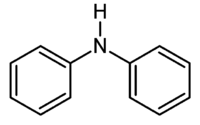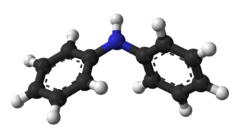Diphenylamine
| Diphenylamine | |
|---|---|
 | |
 | |
| IUPAC name Diphenylamine | |
| Other names N-Phenylbenzenamine; | |
| Identifiers | |
| CAS number | 122-39-4 |
| ChemSpider | 11003 |
| UNII | 9N3CBB0BIQ |
| KEGG | C11016 |
| ChEBI | CHEBI:4640 |
| ChEMBL | CHEMBL38688 |
| RTECS number | 9 |
| Jmol-3D images | Image 1 |
| |
| |
| Properties | |
| Molecular formula | C12H11N |
| Molar mass | 169.23 g/mol |
| Appearance | White crystals |
| Density | 1.2 g/cm³ |
| Melting point | 53 °C (326 K) |
| Boiling point | 302 °C (575 K) |
| Solubility in water | Slightly |
| Hazards | |
| MSDS | External MSDS |
| R-phrases | R23 R24 R25 R33 R50 R53 |
| S-phrases | S36 S37 S45 S60 S61 |
| Main hazards | Toxic. Possible mutagen. Possible teratogen. Harmful in contact with skin, and if swallowed or inhaled. Irritant. |
| NFPA 704 |
 1
3
0
|
| Flash point | 152 °C; 306 °F; 425 K |
| Related compounds | |
| Related Amine | Aniline |
| Supplementary data page | |
| Structure and properties |
n, εr, etc. |
| Thermodynamic data |
Phase behaviour Solid, liquid, gas |
| Spectral data | UV, IR, NMR, MS |
| Except where noted otherwise, data are given for materials in their standard state (at 25 °C (77 °F), 100 kPa) | |
| Infobox references | |
Diphenylamine is an organic compound with the formula (C6H5)2NH. The compound is a derivative of aniline, consisting of an amine bound to two phenyl groups. The compound is a colourless solid, but commercial samples are often yellow due to oxidized impurities.[1]Diphenylamine dissolves well in many common organic solvents, but is insoluble in water.[2] It is used mainly for its antioxidant properties.
Preparation and reactivity
Diphenylamine is manufactured by the thermal deamination of aniline over oxide catalysts:
- 2 C6H5NH2 → (C6H5)2NH + NH3
It is a weak base, with a Kb of 10−14. With strong acids, it forms salts (e.g. reaction with sulfuric acid gives the bisulfate [C6H5)2NH2]+[HSO4]- as a white or yellowish powder with m.p. 123-125°C.[2]
Applications
Diphenylamine is used as a pre- or postharvest scald inhibitor for apples. Its anti-scald activity is the result of its antioxidant properties, which protect the apple skin from the oxidation products of alpha-farnesene during storage.[3]
Diphenylamine derivatives are also useful. Ring-alkylated derivatives of diphenylamine are used as antiozonants in the manufacture of rubber products, reflecting the antioxidant nature of aniline derivatives. The compound undergoes various cyclisaton reactions. With sulfur, it gives phenothiazine, a precursor to certain pharmaceuticals.[4]
- (C6H5)2NH + 2 S → S(C6H4)2NH + H2S
With iodine, it cyclises to carbazole:
- (C6H5)2NH + I2 → (C6H4)2NH + 2 HI
Arylation with iodobenzene gives triphenylamine.[5]
Diphenylamine finds use as a test for nitrates (see nitrate test).
References
- ↑ P. F. Vogt, J. J. Gerulis, “Amines, Aromatic” in Ullmann’s Encyclopedia of Industrial Chemistry 2005, Wiley-VCH, Weinheim. doi:10.1002/14356007.a02_037
- ↑ 2.0 2.1 The Merck Index, 10th Ed., (1983), p.485, Rahway: Merck & Co.
- ↑ W.J. Bramlage "Apple Scald, a Complex Problem" (University of Massachusetts Department of Plant and Soil Sciences) Post Harvest Pomology Newsletter, 6(2): 11-14 September 1988 http://postharvest.tfrec.wsu.edu/pgDisplay.php?article=N6I2C
- ↑ T. Kahl, K.-W. Schröder, F. R. Lawrence, W. J. Marshall, Hartmut Höke, Rudolf Jäckh, "Aniline" in Ullmann's Encyclopedia of Industrial Chemistry, 2005, Wiley-VCH: Weinheim.
- ↑ F. D. Hager (1941), "Triphenylamine", Org. Synth.; Coll. Vol. 1: 544